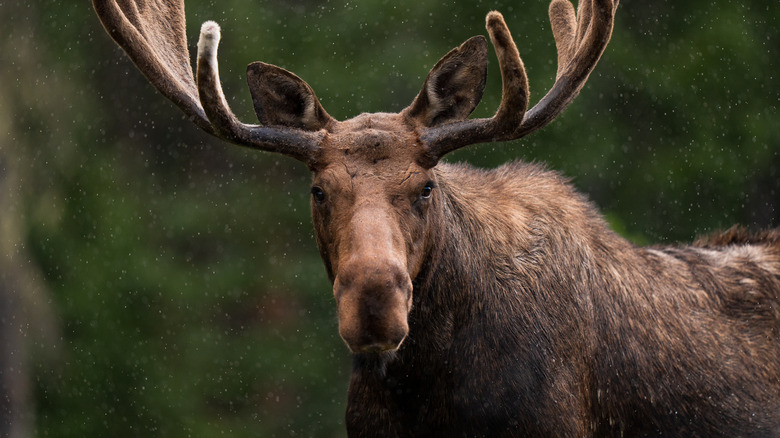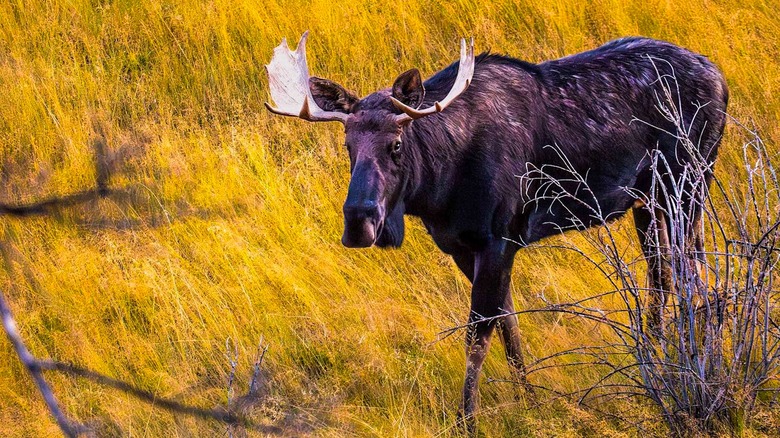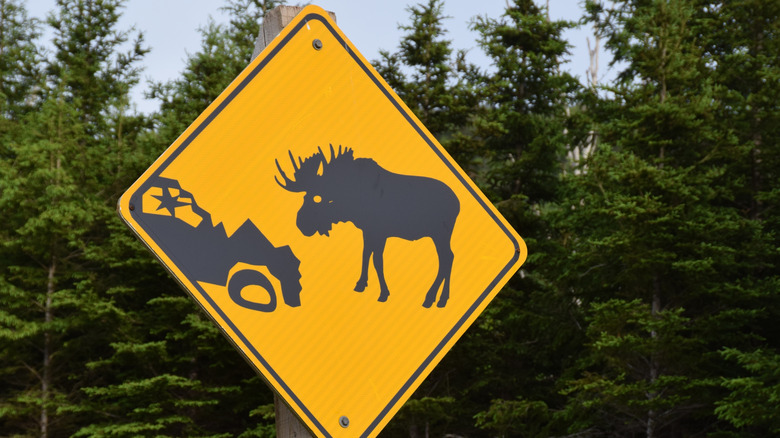Why Moose Are Scarier Than You Think (And What To Do If You See One)
Lions, tigers, and bears might grab most of the headlines, but moose attack more people in Alaska than grizzly and black bears combined. That discrepancy can be partly explained by the fact that more moose live next to populated areas, but still, moose are scarier than you might think. There are two main reasons: (a) they can get up to 1,600 pounds, and (b) they are not afraid of us. While most moose interactions are harmless, they are very territorial creatures, and a few other factors can lead your interactions can go south in a hurry.
In spring and summer, moose are more likely to lash out if there are calves around. Regardless of what animal you encounter in the wild, you never want to get between a calf and its mother. In the fall, male moose, or bull moose, will be extra aggressive as they go through rutting season. During this time, their neck and shoulder muscles can double in size, and a boost in testosterone might cause them to act rashly. Another main reason for moose attacks is that they hate dogs. The Alaska Department of Fish and Game reports that moose dislike dogs so much that they will go out of their way to kick them, even when the dog is on a leash. Regardless of the reasons for an encounter, read on to find out how to escalate and leave the situation intact. Unfortunately, the solution is not to give it a muffin.
What to do if you see a moose
What to do if you cross paths with the locals is something every backpacker needs to know how to handle. Each species will require a slightly different set of tactics to make sure everyone walks out of there unscathed. Surviving a moose encounter will require a different approach than being attacked by a bear. Regardless of which creature you encounter, the first step is a keen awareness of body language. For moose, that means checking whether its ears are pinned back and it's lowering its head. Those are two telltale signs the moose is about to charge. Speak quietly, try to prevent your dog from barking, keep it on a leash if you have one, and remain calm.
Well, remain calm, at least until the moment you see a moose stick its tongue out. While it might seem harmless, a moose sticking its tongue out is a clear indicator that it's getting ready to charge you. Also, try to listen to any grunts or sounds the moose might make. Most moose charges are bluff, but there's no point in sticking around to find out. If you see an aggressive-looking moose start to head towards you, turn around and run. Moose aren't natural predators, so the hope is that they won't chase you very far. To ensure they back off, run toward a large object like a boulder or a tree to create a barrier between you and the moose.
The most dangerous time to see a moose is while you're behind the wheel
For many outdoor activities, statistically speaking, the most dangerous part of the trip is the drive to your destination. That goes double for moose encounters. The New York Times reported that fatal moose attacks against humans "result almost exclusively from vehicle crashes." While there are very few human fatalities, hundreds of moose die each year from these collisions. The Newfoundland Labrador Department of Fisheries, Forestry and Agriculture in Canada says these crashes rack up more than $1 million in car damages each year — and moose don't have insurance.
Moose-vehicle collisions can happen year-round. In warmer Newfoundland and Labrador, moose attacks spike during the summer months, but in the cold, dark Alaskan winters with limited daylight and nasty storms, collisions are five times more likely than they are in the summer.
Year-round, you need to be extra alert from dusk to dawn, as moose might venture further into the roadway and be harder to spot. When traveling through remote areas and dicey conditions, stay sharp and keep an eye on both sides of the road for any signs of movement. Maintaining a safe distance from other vehicles is also crucial to prevent a bad situation from worsening.
Most importantly, if you're driving through moose country and you see one moose, chances are there will be more lurking nearby. Moose crossing signs aren't put down randomly. Stay extra alert after wildlife sightings or when seeing signs, and you'll easily get to your destination in one piece.


